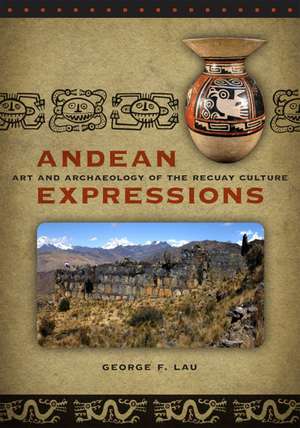Andean Expressions: Art and Archaeology of the Recuay Culture: The Iowa Series in Andean Studies
Autor George F. Lauen Limba Engleză Paperback – 15 apr 2011
Flourishing from A.D. 1 to 700, the Recuay inhabited lands in northern Peru just below the imposing glaciers of the highest mountain chain in the tropics. Thriving on an economy of high-altitude crops and camelid herding, they left behind finely made artworks and grand palatial buildings with an unprecedented aesthetic and a high degree of technical sophistication. In this first in-depth study of these peoples, George Lau situates the Recuay within the great diversification of cultural styles associated with the Early Intermediate Period, provides new and significant evidence to evaluate models of social complexity, and offers fresh theories about life, settlement, art, and cosmology in the high Andes.
Lau crafts a nuanced social and historical model in order to evaluate the record of Recuay developments as part of a wider Andean prehistory. He analyzes the rise and decline of Recuay groups as well as their special interactions with the Andean landscape. Their coherence was expressed as shared culture, community, and corporate identity, but Lau also reveals its diversity through time and space in order to challenge the monolithic characterizations of Recuay society pervasive in the literature today.
Many of the innovations in Recuay culture, revealed for the first time in this landmark volume, left a lasting impact on Andean history and continue to have relevance today. The author highlights the ways that material things intervened in ancient social and political life, rather than being merely passive reflections of historical change, to show that Recuay public art, exchange, technological innovations, warfare, and religion offer key insights into the emergence of social hierarchy and chiefly leadership and the formation, interaction, and later dissolution of large discrete polities. By presenting Recuay artifacts as fundamentally social in the sense of creating and negotiating relations among persons, places, and things, he recognizes in the complexities of the past an enduring order and intelligence that shape the contours of history.
Preț: 300.67 lei
Nou
Puncte Express: 451
Preț estimativ în valută:
57.53€ • 60.23$ • 47.60£
57.53€ • 60.23$ • 47.60£
Carte indisponibilă temporar
Doresc să fiu notificat când acest titlu va fi disponibil:
Se trimite...
Preluare comenzi: 021 569.72.76
Specificații
ISBN-13: 9781587299735
ISBN-10: 1587299739
Pagini: 320
Ilustrații: 15 color & 50 b&w photos, 16 color & 51 b&w drawings, 11 maps, 5 tables, 4 charts
Dimensiuni: 178 x 254 x 28 mm
Greutate: 0.72 kg
Ediția:1
Editura: University of Iowa Press
Colecția University Of Iowa Press
Seria The Iowa Series in Andean Studies
ISBN-10: 1587299739
Pagini: 320
Ilustrații: 15 color & 50 b&w photos, 16 color & 51 b&w drawings, 11 maps, 5 tables, 4 charts
Dimensiuni: 178 x 254 x 28 mm
Greutate: 0.72 kg
Ediția:1
Editura: University of Iowa Press
Colecția University Of Iowa Press
Seria The Iowa Series in Andean Studies
Recenzii
“Notwithstanding its renowned art style, ancient Recuay society has received scant field-based investigation until now. George Lau’s study is pioneering in its comprehensive description, interpretation, and theorization of Recuay, integrating the limited data of earlier archaeologists with the results of his own systematic and intensive research program in the Recuay heartland. Covering environment and settlement patterns, architecture, ritual and vernacular life, textiles, pottery and stone sculpture, chronology, mortuary practices, and sociopolitical organization, Lau’s volume provides a richly contextualized, state-of-the-art account of Recuay prehistory and sets the agenda for necessary new work on this fascinating society. It is a must read for all scholars of the Andes.”—Helaine Silverman, University of Illinois at Urbana-Champaign
Notă biografică
George Lau is a university lecturer at the Sainsbury Research Unit for the Arts of Africa, Oceania and the Americas, School of World Art Studies and Museology, University of East Anglia. He has done fieldwork in highland Peru since 1995. Currently one of the editors of World Art, he is also the author of the forthcoming Ancient Community and Economy at Chinchawas (Ancash, Peru).
